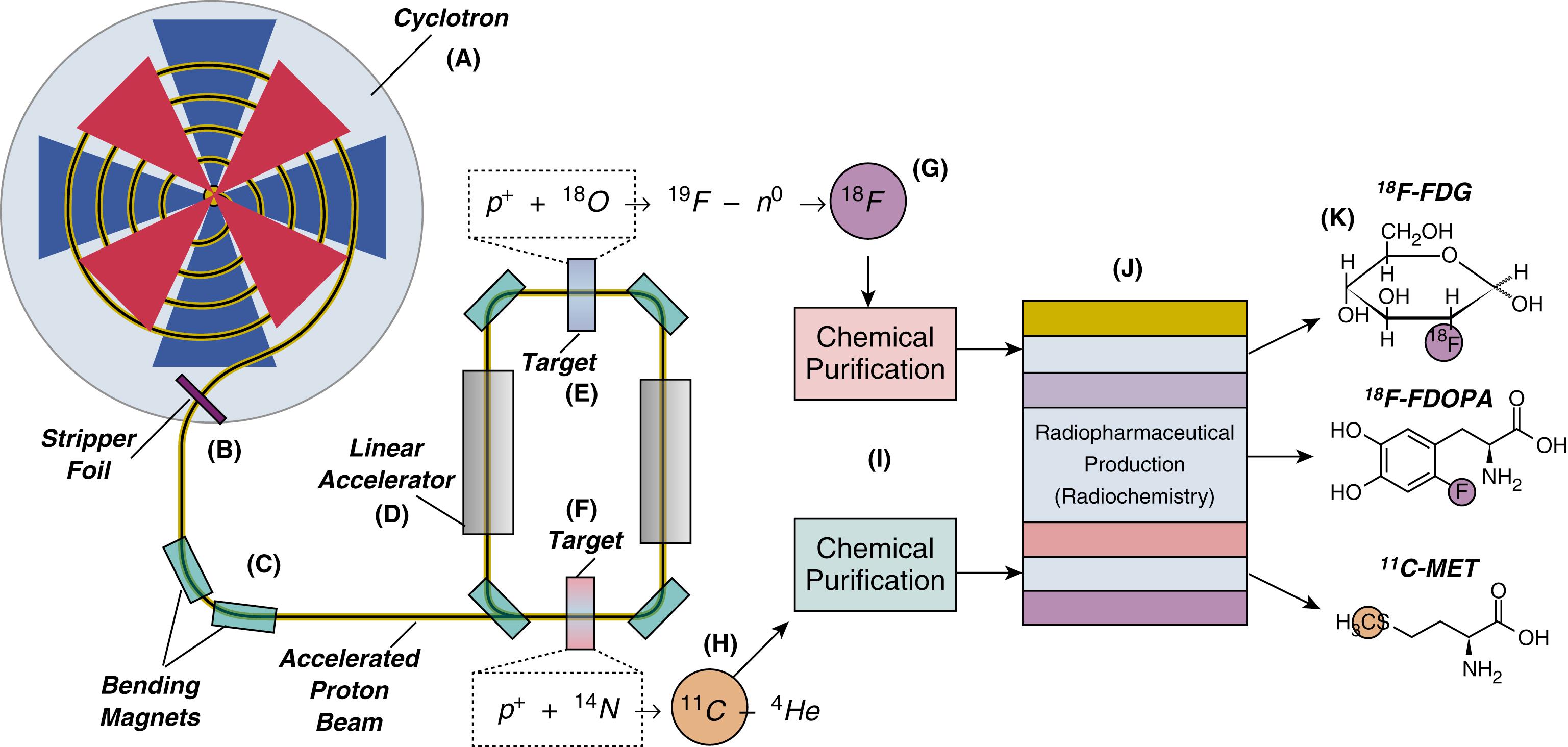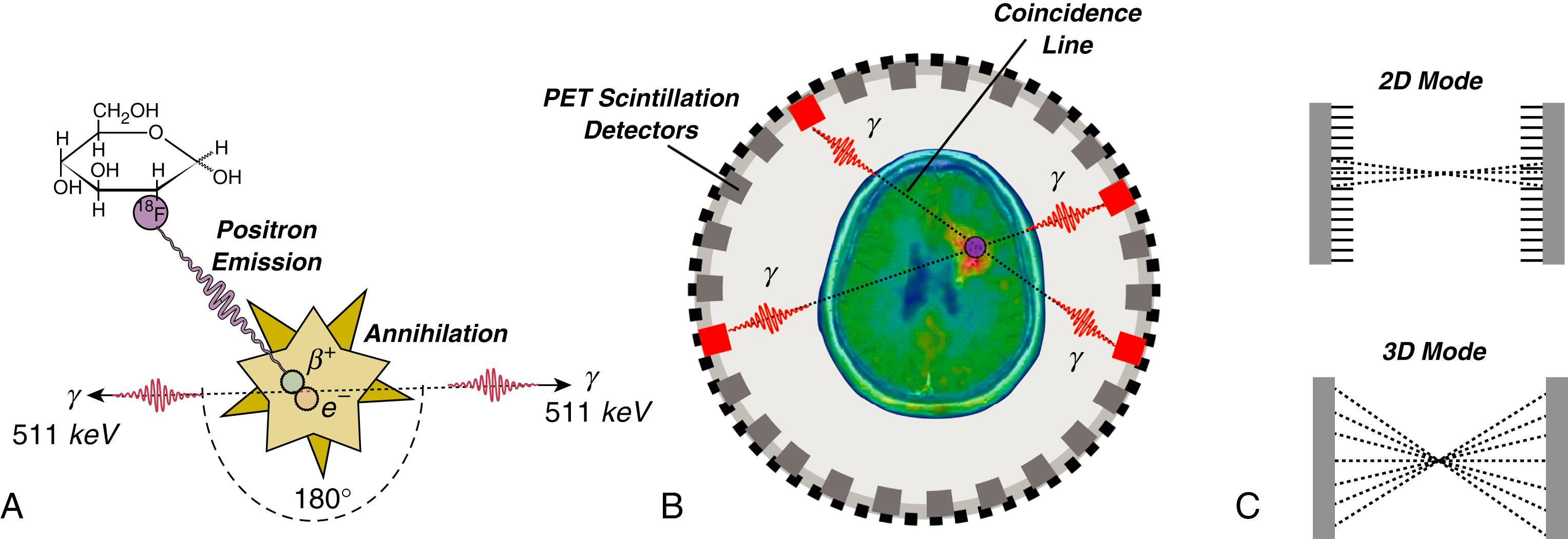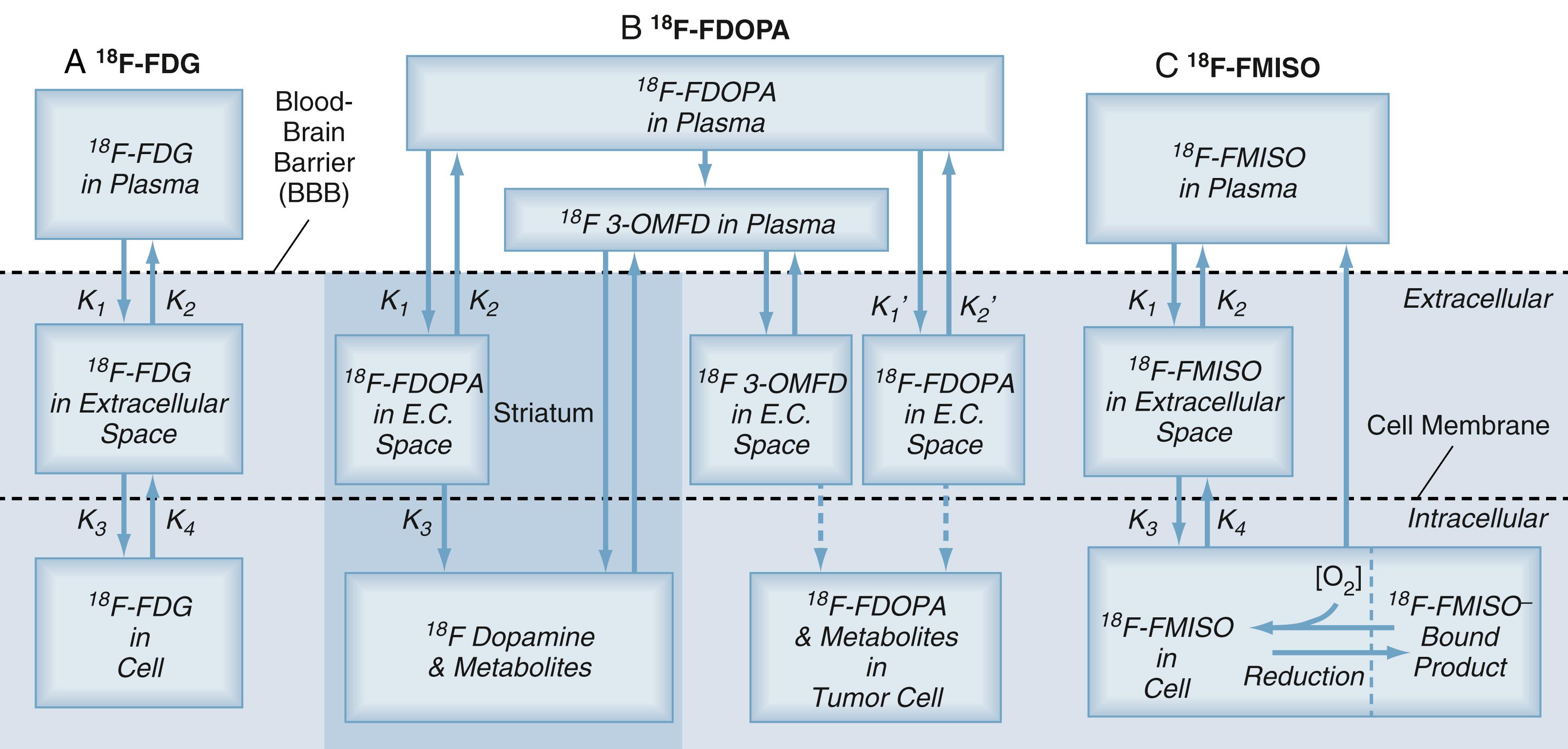Physical Address
304 North Cardinal St.
Dorchester Center, MA 02124
This chapter includes an accompanying lecture presentation that has been prepared by the author: ![]() .
.
PET is a noninvasive imaging technique that allows for in vivo evaluation of biologic processes through (1) production of positron-emitting nuclei using a cyclotron; (2) radiochemical procedures to attach the radionuclide to a molecule of interest and increase purity; (3) injection into the body; (4) measurement of radioactivity through detection of gamma photons on a tomograph camera; (5) mathematical image reconstruction; and (6) application of tracer-kinetic models for quantification of spatial (and temporal) changes in tracer kinetics.
6-[ 18 F]-L-fluoro-L-3, 4-dihydroxyphenylalanine ( 18 F-FDOPA) PET imaging can be used to characterize the integrity of the presynaptic dopaminergic system. Reductions in 18 F-FDOPA PET uptake are often observed in Parkinsonian syndromes, while increased uptake is observed in brain tumors.
[ 18 F]-fluorodeoxyglucose ( 18 F-FDG) PET is used to quantify glucose metabolism and is significantly altered in a number of CNS pathologies. Hypometabolism is observed in dementia and seizure disorders, while hypermetabolism is characteristic of brain tumors, brain injury, and psychiatric diseases.
Amyloid PET imaging probes like 11 C-PIB show promise for early diagnosis and characterization of dementias.
PET ligands directed at specific receptors (e.g., 5-HTT, D 1 , D 2 , GABA A ) allow for targeted imaging of neurotransmitter and cell receptor function. For example, 11 C-flumazenil (GABA A receptor antagonist) has been used to localize seizure foci in epilepsy. Additionally, 11 C-McN5652 or 11 C-DASB (serotonin transporter ligands), 11 C-SCH23390 (D 1 receptor ligand), and 11 C-raclopride or 123 I-iodobenzamide (D 2 receptor ligands) have been used to explore serotonin and dopamine receptor density and occupancy in various psychiatric diseases.
Positron emission tomography (PET) is a powerful technology for noninvasively imaging molecular and biologic processes within the CNS. Although there are high costs associated with the required infrastructure (e.g., the cyclotron, radiochemistry laboratories, PET scanners), PET is ubiquitously used in many research and clinical settings for both novel scientific investigations and routine clinical care. Through use of nanomolar concentrations of radioactively labeled biochemicals, PET imaging allows for quantification and visualization of in vivo chemical processes and molecular interactions. For example, PET can be used to evaluate gene expression, enzyme activity, pH alterations, glucose metabolic rates, blood flow, , blood-brain barrier (BBB) permeability, neurotransmitter receptor characterization, and drug pharmacodynamics. Additionally, PET allows for assessment of motor, visual, somatosensory, and cognitive function in the brain. Also, PET can be used to image alterations in neurochemical activities related to disease states such as movement disorders, dementia, , psychiatric disorders, , epilepsy, stroke, , brain tumors, , traumatic brain injury, , and chronic pain. , Thus, measurements obtained using PET imaging have the potential to vastly improve our knowledge of pathophysiology and support diagnosis, treatment planning, and clinical monitoring of a vast number of neurological disorders.
In this chapter, we will present the major principles associated with PET image acquisition, formation, and quantification, as well as current applications of PET imaging in neurological diseases.
The process of PET imaging consists of the following:
The production of position-emitting nuclei in a cyclotron (e.g. 18 F, 11 C, etc.).
Radiochemical procedures to attach the positron-emitting nuclei to a molecule of interest, also known as a “tracer” or “probe.”
The measurement of radioactivity through use of incidence detection of gamma photons on a tomograph camera.
The creation of images through mathematical image reconstruction.
The application of tracer-kinetic models for interpretation of temporal and regional changes in metabolism.
To create radiopharmaceuticals required for PET imaging, positron-emitting isotopes are first generated in a cyclotron ( Fig. 13.1A ). The cyclotron is a machine in which charged particles (e.g., protons, p + ) are accelerated along a circular path to achieve high kinetic energy. These particles are then directed out of the cyclotron via a stripper foil (see Fig. 13.1B ), where the beam is guided by a number of bending magnets (see Fig. 13.1C ). The accelerated proton beam is then often guided through another series of linear accelerators (see Fig. 13.1D ) until it bombards a stable isotope “target,” such as 18 O (see Fig. 13.1E ) or 14 N (see Fig. 13.1F ). This interaction results in a new, unstable, proton-rich isotope that becomes more stable through a radioactive decay process in which a proton is converted to a neutron, a positron (“antimatter,” which is equivalent to a positively charged electron ), and a neutrino. The positron and neutrino are emitted from the nucleus of this radioactive species at a decay rate characteristic of the particular isotope (e.g., half-life of 15 O is approximately 2 minutes, and half-life of 18 F is approximately 109 minutes). Common positron-emitting isotopes most often used for PET imaging include forms of oxygen ( 15 O), nitrogen ( 13 N), fluorine ( 18 F; see Fig. 13.1G ), and carbon ( 11 C; see Fig. 13.1H ), but other isotopes are also used including 82 Rb, 68 Ga, 62 Cu, 76 Br, and 124 I. Table 13.1 highlights the physical characteristics for various radioisotopes.

| Isotope | Half-life | Positron (β+) Emitting Fraction a | Maximum Energy (MeV) b | Range (mm) c |
|---|---|---|---|---|
| [ 11 C] | 20.4 min | 0.99 | 0.96 | 0.4 |
| [ 13 N] | 9.96 min | 1.00 | 1.20 | 0.7 |
| [ 15 O] | 123 s | 1.00 | 1.74 | 1.1 |
| [ 18 F] | 110 min | 0.97 | 0.63 | 0.3 |
| [ 62 Cu] | 9.74 min | 0.98 | 2.93 | 2.7 |
| [ 64 Cu] | 12.7 h | 0.19 | 0.65 | 0.3 |
| [ 68 Ga] | 68.3 min | 0.88 | 1.83 | 1.2 |
| [ 76 Br] | 16.1 h | 1.00 | 1.90 | 1.2 |
| [ 82 Rb] | 78 s | 0.96 | 3.15 | 2.8 |
| [ 124 I] | 4.18 days | 0.22 | 1.50 | 0.9 |
a Fraction of isotope that emits a pure positron branch. Some radionuclides may decay in multiple modes, not just positrion emission.
b Maximum energy of the emitted positron.
c Approximate distance or range of positron emissions in water.
A series of chemical purification processes occurs following generation of radionuclides ( Fig. 13.1I ), followed by radiochemical procedures to incorporate the radioactive tracers into a wide variety of molecules including physiologic substrates ( Fig. 13.1J ), including glucose, oxygen, or amino acids ( Fig. 13.1K ). Because the compounds are synthesized in very small quantities (nanomolar concentrations), they are also referred to as biologic tracers or probes . The end product is then injected into the body, usually intravenously, before or during the PET imaging examination.
During and following injection of the PET tracer, it continues radioactive decay, emitting positrons and neutrinos. The neutrino passes through the body and is otherwise undetected. The positron ( β + ) travels a short distance (approximately 1 mm) before colliding with a nearby electron ( e – ), resulting in annihilation of the two particles and the conversion of their mass into two gamma ray photons ( γ ), each with an energy of 511 keV and projected at approximately 180° ( Fig. 13.2A ). A pair of detectors set at 180° then registers the time of arrival of these incident photons, creating a line of travel or coincidence line (see Fig. 13.2B ). For a given region having high concentration of the PET probe, photon pairs are emitted in all directions and detected by a circumferential ring of scintillation detectors (“gamma camera” or “tomograph”) that convert these high-energy photons to electrical signals (see Fig. 13.2B ). When the coincidence lines from many different angles are combined, the resulting data are reconstructed through mathematical algorithms (“reconstruction algorithms”) to establish the location of each emission , and form the resulting PET image.

The PET scanner is a sophisticated imaging instrument that acquires data regarding the localization of gamma photon emissions in intervals that range from seconds to minutes, allowing for the dynamic monitoring of biologic processes. The quality and quantity of the acquired data from a particular PET scanner are a function of several technical parameters, including sensitivity, spatial resolution, full-width half-max (FWHM), partial volume, and the type of image reconstruction algorithm used.
Sensitivity refers to the fraction of positron emission events detected by the scanner within a field of view (FOV). As relative sensitivity of a scanner or detector increases, more photon counts from the same amount of radioactivity can be detected, increasing the signal-to-noise ratio (SNR), a measure of performance, and thus overall image quality.
Spatial resolution refers to the smallest distance between two points that can be distinguished by the scanner, or a measure of the ability to accurately localize regions of interest. This parameter defines the limitation of the scanner to differentiate small features and is primarily based on the size and density of the scanner detector elements, with smaller and more compacted elements providing better spatial detail. A typical clinical PET camera has a spatial resolution of 2.5 to 10 mm , with a fundamental physical limit of 1.83 mm, while small animal scanners may have a resolution as low as 0.83 to 2 mm , with a physical limit of 0.67 mm. Detector and scanner technology continue to develop rapidly, as the sensitivity and spatial resolution of PET scanners continue to improve. Data are now often collected in “three-dimensional mode” (3D) compared with “two-dimensional mode” (2D) (see Fig. 13.2C ), which increases the number of photons collected, allowing for imaging and delineation of subregional cortical and subcortical structures. Simply stated, 2D mode utilizes tungsten septa placed before the detectors to act as antidiffusion grids, allowing only photons that were emitted along a 2D plane to be detected as coincidental, or from the same source. In 3D mode the septa are removed, and photons across a larger FOV are allowed to hit the detector and be considered coincidental and from the same emission source. Although 3D mode increases sensitivity by a factor of 5 to 7, , giving it a clear signal-to-noise advantage over 2D mode, 3D mode has a number of complications and confounding issues including higher rates of random coincidences, issues associated with photon scatter, and possible loss of sensitivity in PET scanners with specific types of detectors with long dead time between detected events.
Full width at half maximum (FWHM) refers to the width of a curve at one-half of its maximum value. When radioactivity is acquired from a single point source, the limitations of the PET camera to accurately locate that activity result in a spatial distribution that resembles a bell-shaped curve. The corresponding FWHM of the point-spread function, or response of the imaging system to a point source of radioactivity, is used to define the spatial resolution of the PET scanner.
Partial volume describes errors in the quantitation of PET tracer concentration as a result of activity within regions smaller than twice the spatial resolution of the scanner, or regions smaller than 2×FWHM (e.g. If FWHM is 5 mm, then regions less than 10 mm will be affected by activity in the surrounding areas). This quantity is inherently defined in three dimensions and is based on the point-spread function of the system; however, it is often described in one or two dimensions when referring to partial volume within the image plane. If the structure of interest is smaller than 2×FWHM and has a higher tracer concentration compared with adjacent structures, the radioactivity will be underestimated, whereas if the structure of interest has a lower tracer concentration than adjacent regions, the radioactivity will be overestimated. Generally speaking, a region of interest (ROI) can be quantified only when its size is 2×FWHM. Advanced techniques for improving spatial resolution or accounting for partial volume contamination have been proposed and continue to evolve.
Image reconstruction (computed tomography) refers to the mathematical process of creating an image from a series of gamma photon coincidence detection events obtained from a PET scanner. , , One of the most widely used reconstruction algorithms is called filtered back projection , ; however, more advanced techniques are replacing these approaches on clinical PET scanners, including maximum likelihood–expectation maximization (MLEM) techniques, , ordered subsets expectation maximization (OSEM) techniques, Bayesian methods, , and methods using artificial intelligence (“machine learning” or “deep learning”) technologies. ,
Each PET tracer distributes throughout the brain (and body) on the basis of its delivery, uptake, and metabolic characteristics. Tracer kinetic models can be used to provide additional information beyond static images at a single time point by using a mathematical framework to describe the dynamic distribution and accumulation of PET tracers in various compartments within the brain, including the exchange between the vasculature, extracellular space, cytosol, and mitochondrial compartments. Knowledge of the biologic process is necessary for the construction of kinetic models, and such models are based on differential equations that describe the exchange of the PET tracer among different biologic compartments. In general, these models contain parameters that allow for estimates of transport rates of the tracer into and out of the compartment of interest, as well as the concentration, extent of tracer or ligand-receptor binding, and possibly enzymatic or chemical activities on a voxel-by-voxel basis. The resulting images created after fitting the dynamic PET data to the compartmental models on a voxel-by-voxel basis are often referred to as parametric images, as these are images of the various pharmacokinetic parameters . Commonly, these kinetic parameters are estimated using nonlinear least-squares analyses applied to the governing differential equations.
One of the simplest kinetic models used in PET imaging is the three-compartment tracer kinetic model, which is often used for characterizing 18 F-FDG PET ( Fig. 13.3A ). After intravenous injection of the tracer, the time course of the tracer concentration in plasma (from blood samples) is quantified. Assuming little loss of the tracer (only dispersion) as it travels from the venous to arterial vasculature, the plasma time-activity curve, often referred to as the arterial input function, can be used to provide a quantitative estimate of tracer availability to the brain compartment as a function of time. For this model, 18 F-FDG exchanges with the extracellular, extravascular space through the BBB by the forward rate constant K 1 and backward rate constant k 2 . Both glucose and 18 F-FDG are transported by the same carrier across the BBB, so 18 F-FDG and glucose transfer are assumed to be similar, and both compounds enter into the glycolysis cycle and are phosphorylated by hexokinase (HK), which converts glucose to glucose-6-phosphate. However, unlike glucose, 18 F-FDG-6-phosphate is not a substrate for further metabolism and is instead trapped in the tissue for at least 1 hour before slowly leaving it. Accordingly, the 18 F-FDG-6-phosphate accumulates in the tissue in proportion to the glucose metabolic rate of that tissue. On the basis of the three-compartment model in Fig. 13.3A , the cerebral metabolic rate of glucose (CMRGlc) can be calculated as CMRGlc = C p /[LC (K 1 k 3 /k 2 + k 3 )] , where C p is the plasma glucose concentration, the first-order rate constants K 1 and k 2 represent the transport of 18 F-FDG from plasma to tissue and tissue to plasma, respectively, k 3 represents phosphorylation by hexokinase, and k 4 is assumed to be negligible because it is assumed to be trapped within this compartment for > 1 hour and is released slowly back into the extracellular space ( k 4 ≪ k 3 ).

More sophisticated kinetic models are often required for more sophisticated metabolic characteristics in other types of PET imaging applications. For example, 18 F-FDOPA PET imaging has a relatively complex metabolism in both the striatum and in tumor cells (see Fig. 13.3B ). 18 F-FDOPA is metabolized within the plasma, striatum, and perhaps within tumor cells, and various 18 F-FDOPA-derived metabolites cross the BBB. Within the striatum, 18 F-FDOPA is converted to 18 F-dopamine and other metabolites, which also exchange relatively freely with the blood plasma. In the normal brain, 18 F-FDOPA and metabolites including L-3,4-dihydroxy-6-[ 18 F]fluoro-3-O-methylphenylalanine ( 18 F 3-OMFD) cross the BBB and are transported within tumor cells as a result of increased demand for proliferation, , transamination and transmethylation, , as a substrate for fuel, and as precursors for other biochemical syntheses. [ 18 F]-fluoromisonidazole ( 18 F-FMISO) is a radiolabeled nitroimidazole derivative that can be used for PET imaging of tumor hypoxia, , as 18 F-FMISO-bound metabolites are trapped within hypoxic cells (see Fig. 13.3C ), resulting in different PET kinetics under normoxic and hypoxic conditions.
PET imaging can be used to provide in vivo insight into the underlying pathologic processes involved in many neurological diseases by quantifying the neurochemical and metabolic characteristics for better detection or diagnosis, disease monitoring, and therapeutic response assessment. A variety of biologic substrates, their analogues, and pharmaceuticals have been synthesized for PET tracer assays to understand different components of neurotransmitter pathways. The current section describes PET molecular imaging characteristics of various movement disorders, dementia, psychiatric diseases, epilepsy, brain tumors, stroke, brain injury, chronic pain syndromes and migraine headache.
Become a Clinical Tree membership for Full access and enjoy Unlimited articles
If you are a member. Log in here